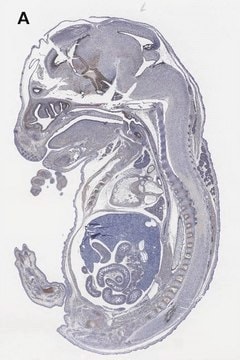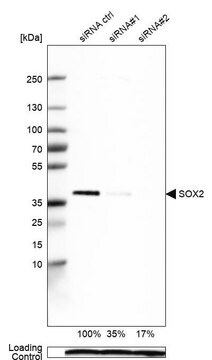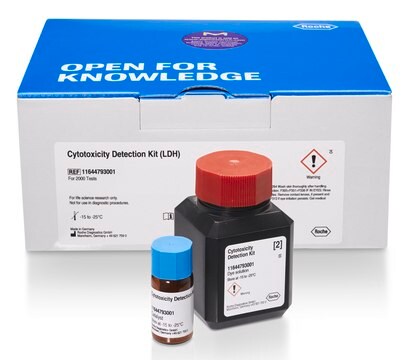SRP3157
Sox2 human
recombinant, expressed in E. coli, ≥95% (SDS-PAGE), ≥95% (HPLC), suitable for cell culture
Iniciar sesiónpara Ver la Fijación de precios por contrato y de la organización
About This Item
Código UNSPSC:
12352200
NACRES:
NA.32
Productos recomendados
origen biológico
human
recombinante
expressed in E. coli
Análisis
≥95% (HPLC)
≥95% (SDS-PAGE)
formulario
lyophilized
mol peso
34.3 kDa
envase
pkg of 25 μg
técnicas
cell culture | mammalian: suitable
impurezas
<0.1 EU/μg endotoxin, tested
color
white
Nº de acceso UniProt
Condiciones de envío
wet ice
temp. de almacenamiento
−20°C
Información sobre el gen
human ... SOX2(6657)
Descripción general
Sox2 (sex determining region Y (SRY)-box 2) is one of the 20 human SOX transcription factors, which are characterized by the highly conserved ∼80-residues DNA-binding HMG (high-mobility group) domain. This domain was initially identified in the testis-determining factor Sry.
Recombinant human Sox2 is a 34.3 kDa protein containing 317 amino-acid residues.
Recombinant human Sox2 is a 34.3 kDa protein containing 317 amino-acid residues.
Acciones bioquímicas o fisiológicas
Sox2 (sex determining region Y (SRY)-box 2) transcription factor participates in maintaining self-renewal and pluripotency of embryonic stem cells. The expression of this protein is aberrant in various human malignancies, and it acts as an oncogene in esophageal squamous cell carcinoma (SCC). SOX2 promotes proilferation, migration and adhesion abilities of dental pulp stem cells (DPSCs), and this might have applications in tissue engineering. It participates in Ewing′s sarcoma cell proliferation, and its inactivation results in apoptosis and G1/S arrest, in a PI3K (phosphoinositide 3-kinase)/Akt pathway-mediated manner.
Secuencia
MYNMMETELK PPGPQQTSGG GGGNSTAAAA GGNQKNSPDR VKRPMNAFMV WSRGQRRKMA QENPKMHNSE ISKRLGAEWK LLSETEKRPF IDEAKRLRAL HMKEHPDYKY RPRRKTKTLM KKDKYTLPGG LLAPGGNSMA SGVGVGAGLG AGVNQRMDSY AHMNGWSNGS YSMMQDQLGY PQHPGLNAHG AAQMQPMHRY DVSALQYNSM TSSQTYMNGS PTYSMSYSQQ GTPGMALGSM GSVVKSEASS SPPVVTSSSH SRAPCQAGDL RDMISMYLPG AEVPEPAAPS RLHMSQHYQS GPVPGTAING TLPLSHM
Forma física
Lyophilized from 10 mM Sodium Acetate, pH 6.0.
Reconstitución
Centrifuge the vial prior to opening. Reconstitute in water to a concentration of 0.1- 1.0 mg/ml. Do not vortex. This solution can be stored at 2-8°C for up to 1 week. For extended storage, it is recommended to further dilute in a buffer containing a carrier protein (example 0.1% BSA) and store in working aliquots at -20°C to -80°C.
Código de clase de almacenamiento
11 - Combustible Solids
Clase de riesgo para el agua (WGK)
WGK 3
Punto de inflamabilidad (°F)
Not applicable
Punto de inflamabilidad (°C)
Not applicable
Certificados de análisis (COA)
Busque Certificados de análisis (COA) introduciendo el número de lote del producto. Los números de lote se encuentran en la etiqueta del producto después de las palabras «Lot» o «Batch»
¿Ya tiene este producto?
Encuentre la documentación para los productos que ha comprado recientemente en la Biblioteca de documentos.
High sex determining region Y-box 2 (SOX2) expression correlates with absence of nodal metastasis in esophageal squamous cell carcinoma.
Chuang WY et al
International Journal of Clinical and Experimental Pathology, 8(8), 9248-9255 (2015)
Effects of SOX2 on Proliferation, Migration and Adhesion of Human Dental Pulp Stem Cells.
Liu P et al
PLoS ONE, 10(10), e0141346-e0141346 (2015)
Inhibition of SOX2 induces cell apoptosis and G1/S arrest in Ewing's sarcoma through the PI3K/Akt pathway.
Ren C et al
Journal of Experimental & Clinical Cancer Research, 35, 44-44 (2016)
The crystal structure of the Sox4 HMG domain-DNA complex suggests a mechanism for positional interdependence in DNA recognition.
Jauch R et al
The Biochemical Journal, 443(1), 39-47 (2012)
Samudyata et al.
Experimental cell research, 381(1), 129-138 (2019-05-12)
Sox2 is a master transcriptional regulator of embryonic development. In this study, we determined the protein interactome of Sox2 in the chromatin and nucleoplasm of mouse embryonic stem (mES) cells. Apart from canonical interactions with pluripotency-regulating transcription factors, we identified
Nuestro equipo de científicos tiene experiencia en todas las áreas de investigación: Ciencias de la vida, Ciencia de los materiales, Síntesis química, Cromatografía, Analítica y muchas otras.
Póngase en contacto con el Servicio técnico







